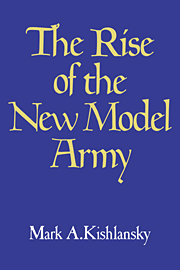7 - The Rise of the New Model Army
Published online by Cambridge University Press: 17 September 2009
Summary
Who would have thought that so modest an address as the late petition drawn up to be subscribed by the Army, to be presented to the general, would have raised so much dust?
Not until the spring of 1647 did the New Model Army become a political participant. During the first two years of its existence the Army acted only in a military capacity, both as a fighting force and as a deterrent to renewed war. To its officers and soldiers the Army's success was plainly the manifestation of God's will. “God is never more seen in his Glory then when He does the greatest works by the most contemptible means; therefore let that new moulded Army be honored.” Military victory vindicated the parliamentary cause and confirmed the special sense Army members had of submerging particular interests in the welfare of the whole. The harmony of heterogeneous political and religious beliefs was exemplified by the New Model. “Presbyterians, Independents, all have here the spirit of faith and prayer, the same presence and answer; they agree here, have no names of difference. Pity it is it should be otherwise anywhere.” By the war's end the soldiery possessed a deep self-esteem derived from their valor, their unity, and their triumph. It was this confidence in their righteousness that encouraged the Army politicization.
The political transformation at Westminster, particularly the emergence of Holles's party and the pursuit of policy to the detriment of unity, did not go unwitnessed by the Army.
- Type
- Chapter
- Information
- The Rise of the New Model Army , pp. 179 - 222Publisher: Cambridge University PressPrint publication year: 1980



